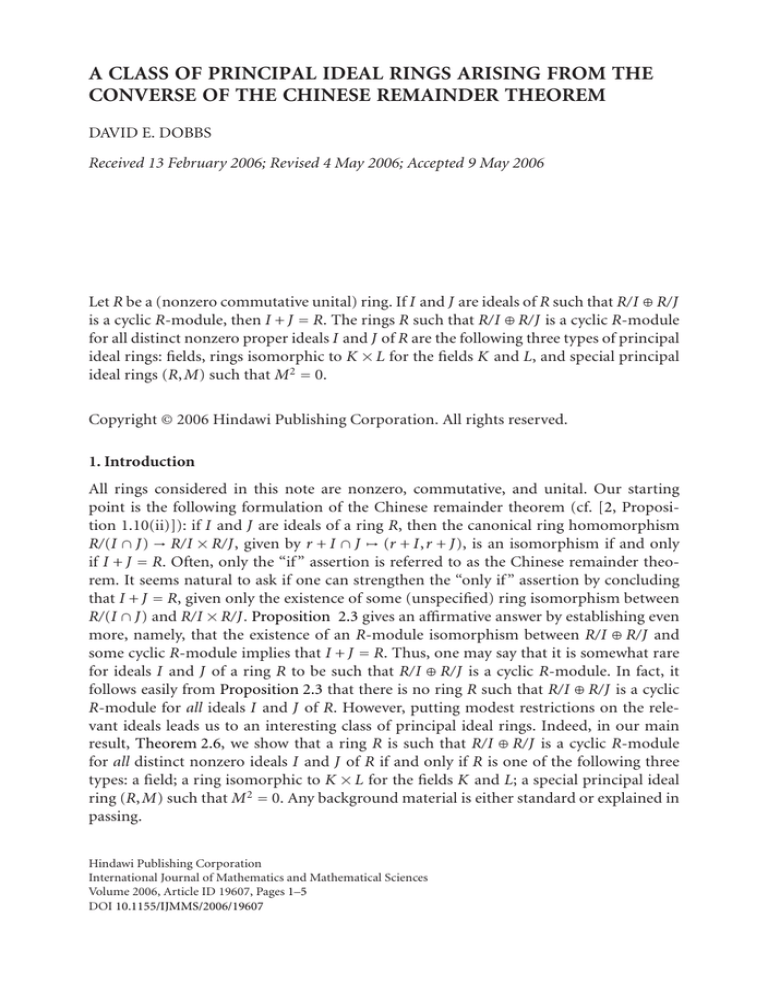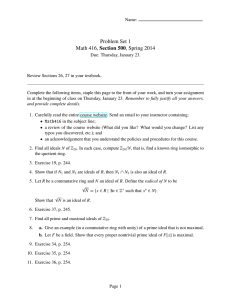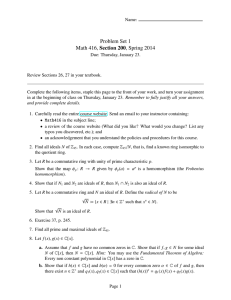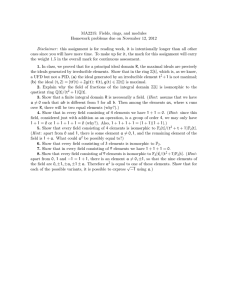
A CLASS OF PRINCIPAL IDEAL RINGS ARISING FROM THE
CONVERSE OF THE CHINESE REMAINDER THEOREM
DAVID E. DOBBS
Received 13 February 2006; Revised 4 May 2006; Accepted 9 May 2006
Let R be a (nonzero commutative unital) ring. If I and J are ideals of R such that R/I ⊕ R/J
is a cyclic R-module, then I + J = R. The rings R such that R/I ⊕ R/J is a cyclic R-module
for all distinct nonzero proper ideals I and J of R are the following three types of principal
ideal rings: fields, rings isomorphic to K × L for the fields K and L, and special principal
ideal rings (R,M) such that M 2 = 0.
Copyright © 2006 Hindawi Publishing Corporation. All rights reserved.
1. Introduction
All rings considered in this note are nonzero, commutative, and unital. Our starting
point is the following formulation of the Chinese remainder theorem (cf. [2, Proposition 1.10(ii)]): if I and J are ideals of a ring R, then the canonical ring homomorphism
R/(I ∩ J) → R/I × R/J, given by r + I ∩ J → (r + I,r + J), is an isomorphism if and only
if I + J = R. Often, only the “if ” assertion is referred to as the Chinese remainder theorem. It seems natural to ask if one can strengthen the “only if ” assertion by concluding
that I + J = R, given only the existence of some (unspecified) ring isomorphism between
R/(I ∩ J) and R/I × R/J. Proposition 2.3 gives an affirmative answer by establishing even
more, namely, that the existence of an R-module isomorphism between R/I ⊕ R/J and
some cyclic R-module implies that I + J = R. Thus, one may say that it is somewhat rare
for ideals I and J of a ring R to be such that R/I ⊕ R/J is a cyclic R-module. In fact, it
follows easily from Proposition 2.3 that there is no ring R such that R/I ⊕ R/J is a cyclic
R-module for all ideals I and J of R. However, putting modest restrictions on the relevant ideals leads us to an interesting class of principal ideal rings. Indeed, in our main
result, Theorem 2.6, we show that a ring R is such that R/I ⊕ R/J is a cyclic R-module
for all distinct nonzero ideals I and J of R if and only if R is one of the following three
types: a field; a ring isomorphic to K × L for the fields K and L; a special principal ideal
ring (R,M) such that M 2 = 0. Any background material is either standard or explained in
passing.
Hindawi Publishing Corporation
International Journal of Mathematics and Mathematical Sciences
Volume 2006, Article ID 19607, Pages 1–5
DOI 10.1155/IJMMS/2006/19607
2
A class of principal ideal rings
2. Results
Propositions 2.1 and 2.3 are essentially known; their simple proofs are included for the
sake of completeness. Recall that if E is an R-module, then the annihilator of E is (0 :R
E) := {r ∈ R | rx = 0 for all x ∈ E}.
Proposition 2.1. If R is a ring, and I and J are ideals of R such that R/I ∼
= R/J as R-modules,
then I = J.
Proof. It is easy to see that if A is any ideal of R, then (0 :R R/A) = A. As isomorphic
R-modules have the same annihilator, we have I = (0 :R R/I) = (0 :R R/J) = J.
The method of proof of Proposition 2.1 leads to the next result, which seems not to
have been explicitly recorded earlier.
Proposition 2.2. If I and J are ideals of a ring R such that R/I ⊕ R/J is a cyclic R-module,
∼ R/(I ∩ J).
then R/I ⊕ R/J =
Proof. By hypothesis, R/I ⊕ R/J is isomorphic as an R-module to R/A for some ideal A of
R. As isomorphic R-modules have the same annihilator, we have A = (0 :R R/I ⊕ R/J) =
I ∩ J, and the assertion follows.
In view of Proposition 2.2, one could restate the results given below in the style of the
Chinese remainder theorem by replacing certain cyclic modules by the corresponding
expressions of the form R/(I ∩ J). In particular, the next result is essentially known; one
needs only to combine Proposition 2.2 with the case A = R of the result of Anderson [1,
Proposition 1(3)] that a finitely generated R-module A satisfies the CC1 property (which
is defined in [1]) if (and only if) (0 :R A) is contained in the Jacobson radical of R.
Proposition 2.3. If R is a ring and I and J are ideals of R such that R/I ⊕ R/J is a cyclic
R-module, then I + J = R.
Proof. We offer two proofs, the first via tensor products and the second via exterior powers.
The first proof is inspired by that of [1, Proposition 1(2)]. If the assertion fails, Zorn’s
lemma supplies a maximal ideal M of R such that I + J ⊆ M (cf. [2, Corollary 1.4]). Consider the field F := R/M. Note, by Proposition 2.2, that R/I ⊕ R/J ∼
= R/(I ∩ J). Applying
the functor F ⊗R −, we see that F ⊗R (R/I ⊕ R/J) and F ⊗R R/(I ∩ J) are isomorphic as
vector spaces over F and, hence, must have the same vector space dimension over F.
However, since IF = 0 = JF, we have that
F ⊗R (R/I ⊕ R/J) ∼
= F/IF ⊕ F/JF ∼
= F ⊗R R/I ⊕ F ⊗R R/J ∼
= F ⊕F
(2.1)
is a two-dimensional vector space over F, while
F ⊗R R/(I ∩ J) ∼
= F/(I ∩ J)F = F/0 ∼
=F
is a one-dimensional vector space over F, the desired contradiction.
(2.2)
David E. Dobbs
3
For the second proof of Proposition 2.3, note (once again by Proposition 2.2) that
R/I ⊕ R/J ∼
= R/(I ∩ J). Applying the second exterior power functor, we have that ∧2R (R/I ⊕
R/J) and ∧2R (R/(I ∩ J)) are isomorphic as R-modules. Now, since ∧2R R/I = 0 = ∧2R R/J, we
see that
∧2R (R/I ⊕ R/J) ∼
= ⊕2i=0
∧iR R/I ⊗R ∧2R−i R/J ∼
= 0 ⊕ R/I ⊗R R/J ⊕ 0
(2.3)
is isomorphic to R/(I + J), while ∧2R (R/(I ∩ J)) = 0. Therefore, R/(I + J) = 0, whence I +
J = R, thus completing the second proof.
The next result gives one sense in which it is rare that a direct sum of cyclic modules is
itself cyclic.
Corollary 2.4. If I is a proper ideal of a ring R, then there exists a maximal ideal M of R
such that R/I ⊕ R/M is not a cyclic R-module.
Proof. Since I is a proper ideal of R, we can choose a maximal ideal M of R such that I ⊆ M
(cf. [2, Corollary 1.4]). As I + M = M = R, the assertion now follows from Proposition
2.3.
Remark 2.5. (a) Corollary 2.4 is best possible, in the sense that there may be only one
maximal ideal M of R which contains the given ideal I. A concrete example where this
occurs is provided by taking R := K × L, where K and L are fields, and I := K ⊕ 0.
(b) Generalizing the construction in (a), consider R := F1 × · · · × Fn , where F1 ,...,Fn
are finitely many fields with n ≥ 3, and I := F1 ⊕ 0 ⊕ · · · ⊕ 0. Then there exist exactly n − 1
maximal ideals M of R such that I ⊆ M. Rings of the above form F1 × · · · × Fn will arise
naturally in the proof of Theorem 2.6.
Recall from [3] that a ring R is called a principal ideal ring if each ideal of R is a principal ideal of R; and a special principal ideal ring (SPIR) if, in addition, R is quasilocal
and its unique maximal ideal is nilpotent. According to a fundamental structure theorem [3, Theorem 33, page 245], principal ideal rings are the rings that are (isomorphic
to) products of finitely many principal ideal domains and finitely many SPIRs. (As usual,
“finitely many” includes the possibility of “at most one.”) If the maximal ideal of an SPIR
has index of nilpotency e(≥ 1), it is convenient to say that R is an SPIR of exponent e. For
instance, if X is an indeterminate over a field F and k is a positive integer, then F[X]/(X k )
is an SPIR of exponent k. One may view fields as the SPIRs of exponent 1.
We next present our main result.
Theorem 2.6. Let R be a ring. Then the following conditions are equivalent:
(1) R/I ⊕ R/J is a cyclic R-module for all distinct nonzero proper ideals I and J of R;
(2) I + J = R for all distinct nonzero proper ideals I and J of R;
(3) R is one of the following three types of (principal ideal) rings: (i) fields; (ii) rings
isomorphic to K × L, for some fields K and L; and (iii) special principal ideal rings of
exponent 2.
Proof. (1)⇒(2) by Proposition 2.3, while(2)⇒(1) by the version of the Chinese remainder
theorem [2, Proposition 1.10(ii)] that was recalled in Section 1.
4
A class of principal ideal rings
(3)⇒(2). Assume that (3) holds. One may verify directly (or cite the above-mentioned
structure theorem [3, Theorem 33, page 245]) to show that R is a principal ideal ring. In
each of the cases (i)–(iii), it is straightforward to verify (2) after first listing all the nonzero
proper ideals of R. Indeed, in case (i), there are no such ideals (and so (2) is satisfied
vacuously). In case (ii), with R identified as K × L, the only nonzero proper ideals of R
are K ⊕ 0 and 0 ⊕ L (and the sum of these two ideals is indeed R, as required in (2)).
Finally, to handle case (iii), first recall from [3, page 245] that if M is the unique maximal
ideal of a special principal ideal ring R of exponent e, then the only ideals of R are the
ideals M i , for i = 0,1,...,e. In particular, in case (iii), e = 2, and so M is the only nonzero
proper ideal of R (whence (2) is satisfied vacuously).
(2)⇒(3). Assume that (2) holds. Without loss of generality, R is not a field. Hence,
each maximal ideal of R is nonzero. Now, if I ⊆ J are nonzero proper ideals of R, then
I + J = J = R, and so it follows from (2) that I = J. Therefore, each nonzero proper ideal
of R is a simple R-module (that is, a simple ideal of R) and, hence, a cyclic R-module.
It follows that R is a principal ideal ring and that each maximal ideal of R is a simple
R-module.
We pause to show that if M is a maximal ideal of R, then RM inherits condition (2)
from R. (The interested reader is invited to show directly that RM inherits condition (1)
from R.) To see this, let I and J be distinct nonzero proper ideals of RM . Since each ideal
of the localization RM is extended from R (see the proof of [2, Proposition 3.11(i)]),
there exist ideals I1 and J1 of R such that I = I1 RM and J = J1 RM . Necessarily, I1 and J1
are distinct and nonzero. Therefore, since R satisfies (2), we have I1 + J1 = R, whence
I + J = I1 RM + J1 RM = (I1 + J1 )RM = RM ; that is, RM satisfies (2), as asserted.
Since R is a principal ideal ring, the fundamental structure theorem allows us to express R as the following internal direct product of rings (which is unique apart from the
ordering of the factors):
R = D1 × · · · × Dn × S1 × · · · × Sk ,
(2.4)
where n and k are nonnegative integers, D1 ,...,Dn are principal ideal domains (possibly
fields), and S1 ,...,Sk are special principal ideal rings of exponent at least 2. We claim that
each Di is a field and that each S j has exponent 2.
Suppose that the claim fails because some Di is not a field. Choose a (nonzero) maximal ideal Ni of Di . Observe that the localization T := (Di )Ni is isomorphic to the localization of R at the maximal ideal of R induced by Ni . (The underlying fact that we are using
about localizations is if A and B are rings and P is a prime ideal of A, then the localizations
(A × B)P×B and AP are isomorphic as rings.) As we have seen that each localization of R
at one of its maximal ideals inherits condition (2), it follows that T satisfies condition (2).
However, T is an integral domain which is not a field, and so we can choose a nonzero
nonunit t of T. Then Tt 2 and Tt are distinct nonzero ideals of T whose sum is Tt = T,
thus contradicting that T satisfies (2). This proves that each Di is a field.
We next show that each (S j ,M j ) has exponent 2. Indeed, we see as above that S j inherits condition (2) from R (since S j = (S j )M j is isomorphic to the localization of R at
the maximal ideal induced by M j ). Therefore, by the final comment in the first paragraph of this part of the proof, M j is a simple S j -module. Since M j is the only maximal
David E. Dobbs
5
ideal of S j , it follows that M j ∼
= S j /M j as S j -modules. Equating annihilators, we find that
(0 :S j M j ) = M j , and so (M j )2 = 0. In particular, S j is of exponent 2, thus proving the
claim.
We can rewrite R = F1 × · · · × Fn × S1 × · · · × Sk , where n and k are nonnegative integers, each Fi is a field, and each S j is a special principal ideal ring of exponent 2. A
case analysis reveals that n + k ≤ 2. For instance, to rule out the possibility that n ≥ 3, observe that (2) would be violated by taking I := F1 ⊕ 0 ⊕ 0 ⊕ · · · and J := 0 ⊕ F2 ⊕ 0 ⊕ · · · ,
since (0,0,1,...) ∈ I + J. The other obstructions to n + k ≤ 2 are dispatched similarly, with
minor changes in notation. Thus, the number of factors, n + k, is either 1 or 2.
It remains only to rule out the possibility that R takes either the form F × S with F a
field and (S,M) an SPIR of exponent 2 or the form S1 × S2 (with (S j ,M j ) being SPIRs of
exponent 2). The first of these forms would violate (2) by taking I := F ⊕ 0 and J := 0 ⊕ M,
for then (0,1) ∈ I + J; and, similarly, the second of these forms would violate (2) by taking
I := M1 ⊕ 0 and J := 0 ⊕ M2 . The proof is complete.
Note that the class Ꮿ of rings R characterized in Theorem 2.6 has some properties
that are reminiscent of properties of the class of all principal ideal rings. For instance,
Ꮿ is stable under the formation of nonzero homomorphic images and nonzero rings of
fractions (and so, in particular, is stable under localization). In addition, Ꮿ is not stable
under the adjunction of indeterminates (since each ring in Ꮿ has Krull dimension 0).
However, unlike the class of all principal ideal rings, Ꮿ is not stable under finite products.
References
[1] D. F. Anderson, The Chinese remainder theorem and the invariant basis property, Canadian Mathematical Bulletin 21 (1978), no. 3, 361–362.
[2] M. F. Atiyah and I. G. Macdonald, Introduction to Commutative Algebra, Addison-Wesley, Massachusetts, 1969.
[3] O. Zariski and P. Samuel, Commutative Algebra, Volume I, The University Series in Higher Mathematics, D. Van Nostrand, New Jersey, 1958.
David E. Dobbs: Department of Mathematics, University of Tennessee, Knoxville,
TN 37996-1300, USA
E-mail address: dobbs@math.utk.edu






